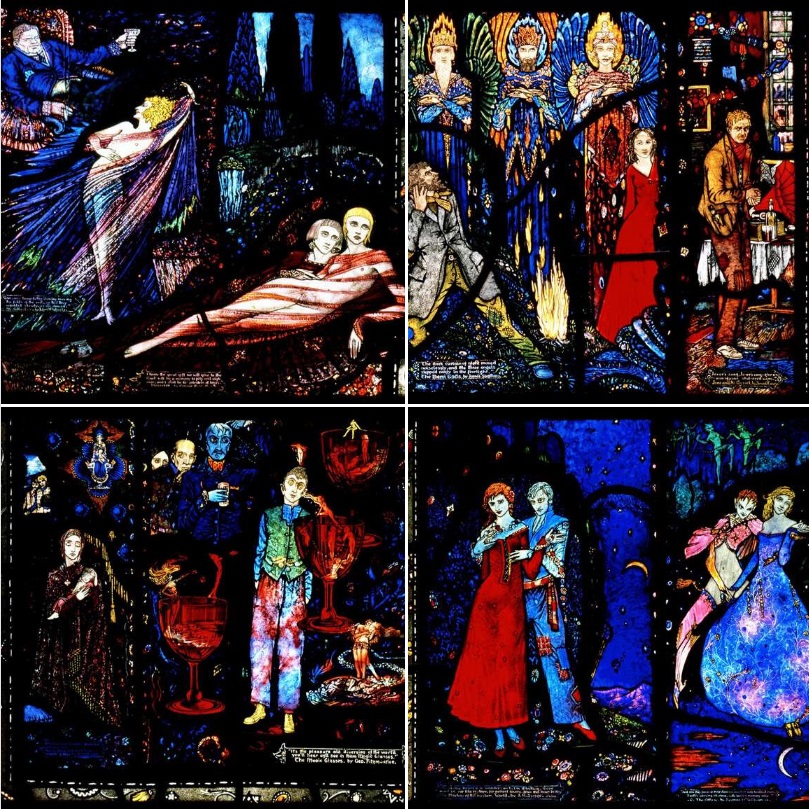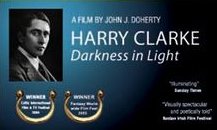Life
| 1889-1931 [Henry Patrick Clarke] b. 18 March 1889 [err. 17th], Dublin, ed. Belvedere; son of Joshua Clark [sic], an Englishman who came to Dublin [aetat. 18], 1877, as a decorator to participate in the Catholic ecclesiastical building revival, with premisses and home at 33, N. Frederick St.; his father m. Bridget MacGonagle, converted to Catholicism and changed his name to Clarke; Harry was sent to Belvedere College; suffered the death of his mother, from TB, at 14 [1903]; apprenticed to his father in glass-studio in 1905; he worked with stained glass under William Nagle; entered Dublin Metropolitan School of Art with a scholarship in 1910 and worked under Alfred Child; won Board of Education awards for stained-glass 1911, 1912, 1913; travelled to France on scholarship, 1914; undertook commission to decorate Honan Chapel, UCC, completed 1917 (incls. a window for St. Gobnait, patroness of bee-keepers); m. Margaret Crilly, also an artist, with whom three children, residing at 48 N. Circular Rd., Dublin; Harry took over the family firm (J. Clarke & Sons); undertook successful book illustrations, generally showing fin-de-siecle influence of Audrey Beardsley; suffered the death of his father, Joshua, 1921, and assumed control of the business besides his own, impairing his health during the 1920s; taught Graphic Design at Dublin Metropolitan School of Art; elected RHA in 1926; stayed in Geneva as a TB convalescent in 1928-30; | 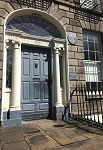 |
|
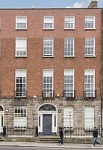 |
Walter then took over running the family business while Harry established Harry Clarke Stained Glass Ltd., in a studio at the family’s Frederick St. premisses, 1930; Harry undertook a commission from Irish Dept. of Commerce and Industry for stained-glass scenes depicting scenes from the Irish Literary Revival for installation in the International Labour Court of the League of Nations (Geneva), 1925 - largely completed in 1928 though not ready for viewing until 1930; the window was moved to the ante-chamber of the Executive Council of Dáil Eireann in 1931, being thought unsuitable for the Irish pavilion in Geneva, and afterwards sold back to his widow in 1933; exhibited in London and sold to the Wolfsonian Museum, Miami, FL., in 1988 [see infra]; Walter Clarke d. July 1930, suddenly of pneumonia; Harry Clarke d., in his sleep, of TB, on 6 Jan. 1931, at Coire [Chur], Switzerland, while returning from Davos-Platz in search of health; his grave was vacated in 1946 [var. 1950] and the headstone destroyed due to his widow’s ignorance of Swiss funerary arrangements; the family business carried on by his son Terence together with Walter’s dg. Ann; his yngr. son David became a painter; Harry Clarke Stained Glass finally closed for want of business in 1973 following a Vatican decree preferring education to church decoration. DIB BREF | |
[ See Frances Clarke, “Harry Clarke”, in the Dictionary of Irish Biography (RIA 2009) - online. ]
|
|
[ top ]
Works| Book illustrations |
|
| Sundry ills. |
|
| Stained glass |
|
 |
| [ Double-click image to view enlarged in separate window. For further details, see Wolfsonian Museum notice - infra.] |
|
[ top ]
Criticism| Full-length studies |
|
| Articles |
|
|
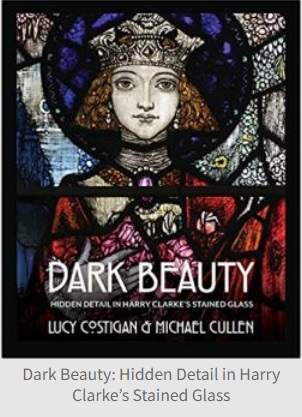 |
| by Lucy Costigan & Michael Cullen (2021) |
[ top ]
Commentary
Nicola Gordon Bowe, ‘Wilhelmina Geddes, Harry Clarke and their part in the Arts and Crafts Movement of Ireland’, The Journal of Decorative and Propaganda Arts [DAPA], No. 8 (Miami 1988), Clarke’s Hans Andersen illustrations were commissioned by George Harrap and successfully published in 1916. This led to the “flesh-creeping” Poe illustrations (in 1919 and 1923), a poetry anthology, The Year’s at the Spring, Perrault’s Fairy Tales, and Goethe’s Faust for Harrap and a Swinburne for Bodley Head. Brentano and Mead & Co. published the American eds., as did a number of pirate printers. Further, Clarke’s window commissioned by Irish Govt for staircase of League of Nations building in Geneva, rejected as unsuitable, and sold back to his widow. It was exhibited in the Style of Empire exhibition (exhibit. No. 159) of the Mitchell Wolfson Jr. collection for DAPA, Miami, 1985-6. [No. 30, 12] A few years earlier he also made a stain glass window for the Jacobs family in Dublin, with “the only proviso that he might incorporate the ideas of Night and Morning, Summer and Winter” (report in Irish Times, 9th & 11th Aug. 1924; cited in Bowe, op. cit., 1988, p.13.
Andrew Haggerty (Broome Community College) writes that the Geneva Window was completed in largely finished in 1928 though not ready for inspection until 1930. Further, the window was viewed and debated by the Executive Council of the Dáil Eireann rather than in full session; the window was erected in the ante-room of the Executive Council chamber during its sojourn in Leinster house; the government took possession of the window in 1931 and returned it to Clarke’s widow in 1933 having held it for just over 2 years. (Email, 21 Nov. 2000.)
Fiana Griffin, ‘The Glass Master’, in The Irish Times, 17 March 2000, Weekend, [feature article] p.5, gives account of Harry Clarke, the son of Joshua Clark who arrived in Dublin aged 18 in 1877 to participate in the Catholic ecclesiastical building revival; estab. own church decoration firm; converted to Catholicism; m. Bridget MacGonagle, of Sligo; adapted ‘Clarke’ spelling; Harry and Walter Clarke, b. 17 March in 1887 and 1889; resided in N. Frederick St.; summer house in Bray; ed. Belvedere College; Joshua opened glass studio in home; ed. Metropolitan School of Art; teavelling schol. to France; death of father in 1921; assisted Clarke took on the family firm (J. Clarke & Sons); health suffered from overwork, 1920s; Walter took over and Harry established Harry Clarke Stained Glass Ltd., 1930; Walter d. July 1930; Harry d., Jan. 1931, in Switzerland; grave vacated in 1946 and headstone destroy, the rental having been inadvertantly overlooked (no one explains to Margaret); business perpetuated by his son Terence and Walter’s dg. Ann; yngr. son David, a painter; Harry Clarke Stained Glass closes, 1973, as a result of Vatican Council policy on decoration; Bewley’s windows; “Eve of St. Agnes”, Municipal Gallery; Geneva Window displyed in Municipal (Hugh Lane) Gallery, 1963-1980; illustrates extracts from 15 Irish writers; intended gift to International Court, Geneva; 11 windows in Honan Hostel Chapel, Cork (UCC).
[ top ]
Tony Canavan, ‘“The loveliest thing ever made by an Irishman”: Harry Clarke’s Geneva Window’ [second Glance, column], in History Ireland (March/April 2011), p.34: W. T. Cosgrave opened an exhibition in the Harry Clarke Studios at N. Frederick St., in 1925; Clarke was approached to make a window for the Irish office in the International Labour Court, Geneva, in 1926; visited Geneva, 1926; designed a work with scenes from 15 Irish writers; the work displayed in his Studios in May 1930; a letter from Cosgrave expressed anxiety about the contents, especially the scenes from Liam Cosgrave’s Mr. Gilhooley: ‘considerations arise where a window is being presented on behalf of the government which in the ordianry course would not occur to the artist’. A further letter objected to ‘scenes from certain authors as representative of Irish literature and culture [which] would give grave offence to many of our people’ - objections taken to refer particularly to a panel featuring two naked women (and including quotations from O’Flaherty and from “Æ” [George Russell]), but also more broadly to the inclusion of writers of such dubious morality as O’Flaherty and Joyce as well as the depiction of poverty, prostitution, drinking, and dancing. Clarke returned to Geneva for treatment for tuberculus in Oct. 1930 and continued to correspond with the Government; continued writing up to his death on 6 Jan. 1931; three weeks later his wife Margaret received £450 and notification that the window would be housed in govt. buildings on Merrions Sq.; in 1932 Sean Lemass, then Minister for Industry and Commerce, sold the window back to her. The window was described by Thomas Bodkin as ‘The loveliest thing ever made by an Irishman’; in 1988 Clarke’s sons David and Michael sold it to Mitchell Wolfson, an American collector, who housed it in collection-museum at Miami Beach, Florida. Canavan’s article reproduces the whole window and, on a large scale, the offending pane figuring O’Flaherty’s novel, with the text: ‘She came towards him dancing, moving the folds of the veil, so that they unforlded slowly, as she danced’ (top left-hand corner), and, from “Æ” [George Russell]’s Deirdre: ‘I know the great gift we will give to the Gael will be a memory to pity and sigh over; and I shall be the priestess of tears’ (Canavan, op. cit., p.34.)
[ top ]
References
Hyland Catalogue 219 (1995) lists Lennox Robinson, The Whiteheaded Boy: Play in Three Acts (n.d. [?1918]) [cover designed by Harry Clarke].
| See Artnet biographical record taken from Grove Dictionary of Art |
| [...] In 1913 Clarke went to London where he was commissioned by the publishers George G. Harrap & Co. to illustrate a special edition of Hans Christian Andersen’s Fairy Tales (1916). His decorative, whimsical style reflects the work of not only Aubrey Beardsley and Gustav Klimt but also such illustrators of fantastical work as Kai Neilsen and Léon Bakst, whose work he saw in London. Clarke later illustrated Edgar Allan Poe’s Tales of Mystery and Imagination (1919), the anthology The Year’s at the Spring (1920) and The Fairy Tales of Perrault (1922) for Harrap. In 1915 he received his first stained-glass commission for the Honan Collegiate Chapel, University College, Cork, which was completed in March 1917. His brilliant colouring and lush sensuous fantasy, even in sacred subjects, were very influential and often had a morbid bent. He was elected an Associate of the Royal Hibernian Academy in 1925 and Royal Hibernian Academician in 1926. He designed panels for Bewley’s Oriental Café (1927), Grafton Street, Dublin, and for private collectors. His most celebrated work is the Eve of St Agnes (Dublin, Hugh Lane Mun. Gal.), commissioned by Harold Jacob in 1924. His masterpiece, the Geneva Window (1929), commissioned by the Irish Government in 1927, depicts scenes from 20th-century Irish literature with daring originality. It was not accepted and was eventually loaned to the Municipal Gallery of Modern Art, Dublin. In 1988 it was purchased by the Mitchell Wolfson jr Collection of Decorative and Propaganda Arts in Miami. |
| —View online [extant at 03.03.2011]. |
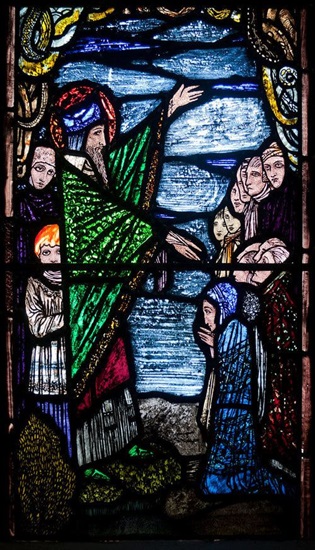 |
| St Patrick Preaching to his Disciples (St. Michael’s, Ballinasloe) [ 20th c. Irish Art on Facebook - 17 March 20024] |
[ top ]
Notes
Hans Andersen: Clarke’s illustrations for the fairy-tales of Hans Christian Andersen were commissioned by George Harrap and successfully published in 1916. This led on to the “flesh-creeping” Poe illustrations (in 1919 and 1923), a poetry anthology, The Year’s at the Spring, Perrault’s Fairy Tales, and Goethe’s Faust for Harrap and a Swinburne for Bodley Head. Brentano and Mead & Co. published American eds., as did a number of pirate printers.
Áras an Uachtarain: a small framed stained-glass by Harry Clarke which was discovered in Áras an Uachtarain in c.2000 now stands in the private chapel of the President of Ireland.
Eoin Duignan has created a traditional Irish music suite in response to Harry Clarke stained glass windows at Diseart chapel, Dingle. Acc. to Duignan: ‘The big turning point for me was discovering that Johnny Doran, the piper, was a good friend of Harry Clarke’s. For me that was the green light that dispelled any doubt I had about how the recording would be accepted, how it would come across and what the reaction would be to it. I didn’t have the confidence to just go for it until I read about that friendship. If Harry Clarke liked that music, then I just had to give it a go. I also had a lot of connections with Inis Oírr, and that’s where Clarke and Doran used to hang out together, so that made it feel right too.’ Duignan is a celebrated piper, here turning to the low whistle for its emotional effect. Contributors to the album include Liam Ó Maonlaoí (Hothouse Flowers), Steve Coulter (harpist), Máire Breatnach (fiddle and viola), James Blennerhassett (bassist), Virginia McKee (clarinettist) and Jon Sanders (Indian-harmonium player). See Siobhán Long, ‘Windows to the soul’, in The Irish Times, 30 July 2004.)
Bewleys’, Ltd.: Bewley’s Cafés, Dublin, in whose Grafton St. branch a number of Harry Clarke stained-glass windows are housed, confirmed that it may remove the windows from Grafton Street when it closes the café there. Installed by the Bewley family in 1927, the windows are owned by the company although the building has since been sold to Treasury Holdings. (See Irish Times, 30 October 2004.)
Note, a Harry Clarke window, removed from Mungret College at its closure in the 1970s, forms a feature of the renovated café at Westmoreland St, also due to close.
Bewleys' Ltd.: In 1986, Bewley’s was acquired and operated by the Campbell Bewley Group Ltd. belonging to Patrick Campbell, a sculptor and businessmen. The café was closed during Nov. 2004 - May 2005 following renovations which were the subject of a challenge on the part of Ickendel Ltd., the leasee of the building. Lunchtime drama has been conducted successfully in the Oriental Room for several years.
Wolfsonian notice on Geneva Window (held in Miami, Florida, USA):Nicola Gordon Bowe: Her Life and Work of Harry Clarke (Dublin: IAP 1984; [2nd edn., with forewords by Penelope Hunter-Stiebel, James White, et al.] (1994) - originated as The Life and Work of Harry Clarke (1889-1931), a three-vol. doctoral dissertation written at TCD (Fine Arts), in 1982. Her supervisor was Anne Cruikshank. On first publication by Irish Academic Press, the book won the Prix de la Confédération Internationale des Négociants en Oeuvres d’Art for 1984. Nicola, the daughter of an Anglican bishop, married Patrick (“Paddy”) Bowe, an architect, at Leixlip Castle and settled at Parsley Cottage, a terrace house in Ranelagh and also had a home at Glenmalure, Co. Wicklow. For thirty years she taught at the National College of Art, Dublin (NCAD) and founded the Master’s course in Design History and Applied Arts - built around her own research and others into the Irish Arts and Crafts Movement. She died unexpectedly on 4 Jan. 2018. she was survived by her husband and their daughter Venetia. (There is a Wikipedia notice - online; accessed 08.11.2021.)
| In June 1925 a representative of the Irish Department of Industry and Commerce asked Harry Clarke if he would be interested in designing a stained glass window for the International Labour Court in Geneva. By May 1927 Harry had submitted his proposal and subjects to the Minister. |
| In March 1929 his health deteriorated and he was forced to travel to a sanitorium in Davos-Platz, Switzerland. Harry left two of the Studio staff to complete the final processes on the Geneva window. The government passed the authors and subjects that were depicted on the panels. The window depicted scenes from literature by fifteen of Ireland’s finest writers. Harry selected the writers to be depicted with the help of William Butler Yeats. The writers chosen, in the order they appear on the panels in clockwise direction, were: George Bernard Shaw, James Stephens, Sean O’Casey, Liam O’Flaherty, AE (George Russell), Seumas O’Kelly, James Joyce, George Fitzmaurice, Padraic Colum, Lennox Robinson, William Butler Yeats, Seamus O’Sullivan, John Millington Synge, Lady Gregory, and P.H. Pearse. |
| Many of the writers included were part of the Celtic Revival; some were members of the Gaelic League, while others were involved with the Abbey Theatre (The Wolfsonian: Harry Clarke and the Irish Free State). Harry also depicted works by disgraced writers, such as Joyce and O’Flaherty. Several writers were protestant. On Harry’s return to Dublin in March 1930, he put the finishing touches to the window. It was viewed by government ministers later that year. Harry received a letter dated September 26th 1930 from President Cosgrave in which he expressed his opinion that the O’Flaherty panel, depicting Mr. Gilhooley, would need to be replaced. |
| The scene chosen to represent Liam O’Flaherty’s Mr. Gilhooley depicted a scantily-clad female dancer. Harry replied to President Cosgrave, asking that the President would call to the Studios to discuss two alternatives to replacing the panel. The proposed meeting, however, never took place (Clarke: 1988). On October 2nd 1930, Harry left Dublin with his friend, Lennox Robinson, for Davos. Harry continued to inquire about the fate of the window, right up until his death on January 6th 1931 but he never received any decision. The Irish government ultimately rejected the window and it was never installed in Geneva. The window was installed in Government Buildings in Merrion Square until Margaret, Harry’s widow, bought it back in 1932. The window was exhibited for some years at the Hugh Lane Municipal Gallery of Modern Art in Dublin, and by the Fine Art Society in London. In 1988 the Geneva window was sold by Harry’s sons to an art collector, Mitchell Wolfson. The window has finally found a home and is considered a rare masterpiece at the Wolfsonian, at the University of Florida, Miami. |
|
| Accessed at Wolfsonian Museum / Harry Clarke - online - 10.02.2023. |
[ top ]
